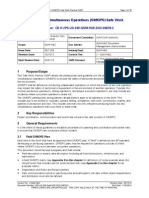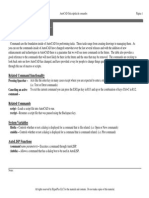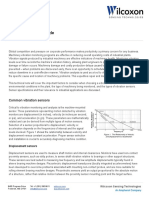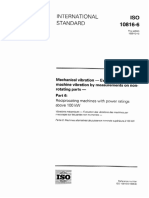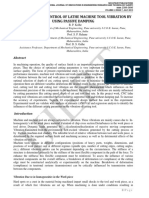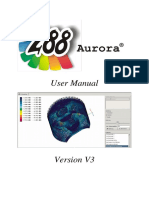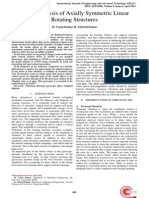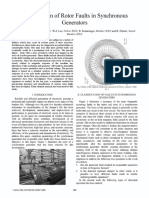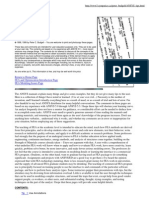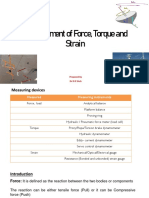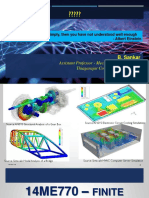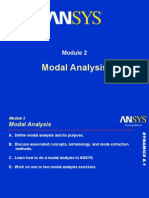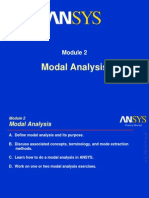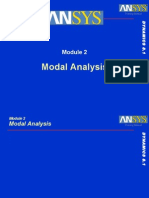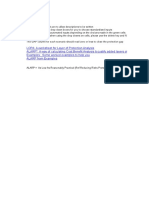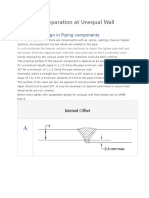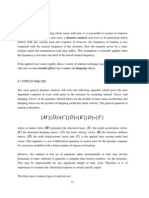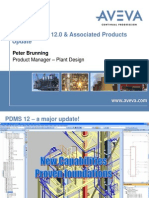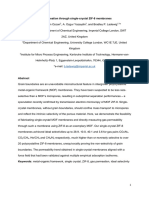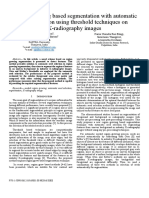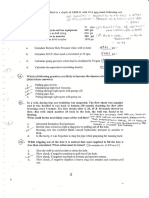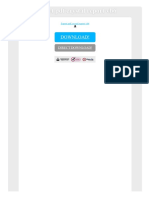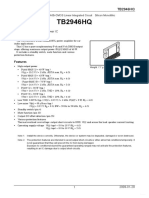ANSYS Modal Analysis
ANSYS Modal Analysis
Uploaded by
Desmond ChangCopyright:
Available Formats
ANSYS Modal Analysis
ANSYS Modal Analysis
Uploaded by
Desmond ChangOriginal Description:
Copyright
Available Formats
Share this document
Did you find this document useful?
Is this content inappropriate?
Copyright:
Available Formats
ANSYS Modal Analysis
ANSYS Modal Analysis
Uploaded by
Desmond ChangCopyright:
Available Formats
Module 2
Modal Analysis
Module 2
Modal Analysis
Training Manual
B. Discuss associated concepts, terminology, and mode extraction
methods.
C. Learn how to do a modal analysis in ANSYS.
DYNAMICS 8.1
A. Define modal analysis and its purpose.
D. Work on one or two modal analysis exercises.
July 22, 2004
Inventory #002110
2-2
Modal Analysis
A. Definition & Purpose
What is modal analysis?
A technique used to determine a structures vibration
characteristics:
Natural frequencies
Mode shapes
Mode participation factors (how much a given mode participates in a
given direction)
DYNAMICS 8.1
Training Manual
Most fundamental of all the dynamic analysis types.
July 22, 2004
Inventory #002110
2-3
Modal Analysis
Definition & Purpose
Training Manual
DYNAMICS 8.1
Benefits of modal analysis
Allows the design to avoid resonant vibrations or to vibrate at a
specified frequency (speakers, for example).
Gives engineers an idea of how the design will respond to
different types of dynamic loads.
Helps in calculating solution controls (time steps, etc.) for other
dynamic analyses.
Recommendation: Because a structures vibration characteristics
determine how it responds to any type of dynamic load, always perform a
modal analysis first before trying any other dynamic analysis.
July 22, 2004
Inventory #002110
2-4
Modal Analysis
B. Terminology & Concepts
DYNAMICS 8.1
Training Manual
General equation of motion:
Mu Cu Ku Ft
Assume free vibrations and ignore damping:
Mu Ku 0
Assume harmonic motion ( i.e.
u U sin( t ) )
K Mu 0
2
The roots of this equation are i2, the eigenvalues, where i ranges
from 1 to number of DOF. Corresponding vectors are {u}i, the
eigenvectors.
July 22, 2004
Inventory #002110
2-5
Modal Analysis
Terminology & Concepts
Training Manual
The square roots of the eigenvalues are i , the structures natural
circular frequencies (radians/sec). Natural frequencies fi are then
calculated as fi = i /2p cycles/sec. It is the natural frequencies fi
that are input by the user and output by ANSYS.
The eigenvectors {u}i represent the mode shapes - the shape
assumed by the structure when vibrating at frequency fi.
DYNAMICS 8.1
July 22, 2004
Inventory #002110
2-6
Modal Analysis
Terminology & Concepts (cont.)
Training Manual
Mode Extraction is the term used to describe the calculation of
eigenvalues and eigenvectors.
Mode Expansion has a dual meaning. For the reduced method,
mode expansion means calculating the full mode shapes from the
reduced mode shapes. For all other methods, mode expansion
simply means writing mode shapes to the results file.
DYNAMICS 8.1
July 22, 2004
Inventory #002110
2-7
Modal Analysis - Terminology & Concepts
Mode Extraction Methods
Several mode extraction methods are available in ANSYS:
Block Lanczos (default)
Subspace
PowerDynamics
Reduced
Unsymmetric
Damped (full)
QR Damped
DYNAMICS 8.1
Training Manual
Which method you choose depends primarily on the model size
(relative to your computer resources) and the particular
application.
July 22, 2004
Inventory #002110
2-8
Modal Analysis - Terminology & Concepts
Mode Extraction Methods - Block Lanczos
The Block Lanczos method is recommended for most
applications.
Efficient extraction of large number of modes (40+) in most models
Typically used in complex models with mixture of
solids/shells/beams etc.
Efficient extraction of modes in a frequency range
Handles rigid-body modes well
DYNAMICS 8.1
Training Manual
July 22, 2004
Inventory #002110
2-9
Modal Analysis - Terminology & Concepts
Mode Extraction Methods - Subspace
When extracting a small number of modes (<40) in similar size
models, the subspace method can be more suitable.
Requires relatively less memory but large diskspace
May have convergence problems when rigid body modes are present.
Not recommended when constraint equations are present.
Generally superseded by Block Lanczos
DYNAMICS 8.1
Training Manual
July 22, 2004
Inventory #002110
2-10
Modal Analysis - Terminology & Concepts
Mode Extraction Methods - PowerDynamics
For large (100K+ DOF) models and a small number of modes
(< 20), use the PowerDynamics method. It can be significantly
faster than Block Lanczos or Subspace, but:
Requires large amount of memory.
May not converge with poorly shaped elements or an ill-conditioned
matrix.
May miss modes (No Sturm sequence check)
Recommended only as a last resort for large models.
DYNAMICS 8.1
Training Manual
July 22, 2004
Inventory #002110
2-11
Modal Analysis - Terminology & Concepts
Mode Extraction Methods - Reduced
For models in which lumping mass does not create a local
oscillation, typically beams and spars, use the Reduced method.
Memory and disk requirements are low.
In general fastest eigen solver
Employs matrix reduction, a technique to reduce the size of [K] and
[M] by selecting a subset of DOF called master DOF.
DYNAMICS 8.1
Training Manual
Reduction of [K] is exact but [M] loses some accuracy
Accuracy of [M] depends on number and location of master DOF.
Generally not recommended due to
Expertise required in picking master DOF
Efficient alternatives such as Block Lanczos
reduced cost of hardware
July 22, 2004
Inventory #002110
2-12
Modal Analysis - Terminology & Concepts
Mode Extraction Methods - Unsymmetric
The unsymmetric method is used for acoustics (with structural
coupling) and other such applications with unsymmetric [K] and [M].
Calculates complex eigenvalues and eigenvectors:
Real part is the natural frequency.
Imaginary part indicates stability - negative means stable, positive
means unstable.
DYNAMICS 8.1
Training Manual
July 22, 2004
Inventory #002110
2-13
Modal Analysis - Terminology & Concepts
Mode Extraction Methods - Damped
Damping is normally ignored in a modal analysis, but if its effects
are significant, the Damped method is used.
Typical application is rotor dynamics, where gyroscopic damping
effects are important.
Two ANSYS elements, BEAM4 and PIPE16, allow gyroscopic effects to
be specified in the form of real constant SPIN (rotational speed,
radians/time).
Calculates complex eigenvalues and eigenvectors:
DYNAMICS 8.1
Training Manual
Imaginary part is the natural frequency.
Real part indicates stability - negative means stable, positive
means unstable.
July 22, 2004
Inventory #002110
2-14
Modal Analysis - Terminology & Concepts
Mode Extraction Methods - Q-R damped
A second mode extraction method that considers damping effects
is the Q-R Damped method.
Faster and more stable than the existing Damped Solver
Works with poorly conditioned models
All forms of damping allowed including damper elements
Combines the best features of the real eigensolution method (Block
Lanczos) and the Complex Hessenberg method (QR Algorithm)
Outputs complex eigenvalues ( frequency and stability) and damping
ratio of each mode
Supports the use of a material dependent damping ratio [MP,DMPR] in
a subsequent mode superposition harmonic analysis
DYNAMICS 8.1
Training Manual
July 22, 2004
Inventory #002110
2-15
Modal Analysis - Terminology & Concepts
Mode Extraction Methods - Q-R damped
DYNAMICS 8.1
MODOPT,QRDAMP,NMODE
Training Manual
July 22, 2004
Inventory #002110
2-16
Modal Analysis - Terminology & Concepts
Mode Extraction Methods - Q-R damped
Training Manual
FEA Model Characteristics:
111,129 active dofs
10 damped modes
Alpha, Beta and Element damping
DYNAMICS 8.1
Comparison Demonstrating the Superior Solution Performance
of the QR Damped Mode Extraction Method
160000
140000
120000
100000
CPU (sec)
80000
ELAPSE (sec)
60000
40000
20000
0
QRDAMP
DAMP
July 22, 2004
Inventory #002110
2-17
Modal Analysis - Terminology & Concepts
Summary for symmetric, undamped solvers
Linear Solver
Used
Block Lanczos
Sparse Matrix
Subspace
Frontal Solver
Powerdynamics PCG solver
Reduced
Frontal Solver
Remarks
Recommended for most applications; Most stable;
Stable but slow; Requires large disk space; Has
difficulty with constraint equations / rigid body
modes
Same as subspace but with PCG solver; Can
handle very large models; Lumped mass only; May
miss modes; Modes cannot be used in
subsequent spectrum and PSD analyses
In general fastest; Accuracy depends on Master
DOF selection; Limitations similar to Subspace;
Not recommended due to expertise required in
selecting Master DOF.
DYNAMICS 8.1
Extraction
method
Training Manual
July 22, 2004
Inventory #002110
2-18
Modal Analysis
C. Procedure
Build the model
Choose analysis type and options
Apply boundary conditions and solve
Review results
DYNAMICS 8.1
Four main steps in a modal analysis:
Training Manual
July 22, 2004
Inventory #002110
2-19
Modal Analysis Procedure
Build the Model
Training Manual
Remember density!
Linear elements and materials only. Nonlinearities are ignored.
See also Modeling Considerations in Module 1.
DYNAMICS 8.1
July 22, 2004
Inventory #002110
2-20
Modal Analysis Procedure
Choose Analysis Type & Options
Choose analysis type and
options
Enter Solution and choose
modal analysis.
Mode extraction options*
Mode expansion options*
Other options*
*Discussed next
DYNAMICS 8.1
Build the model
Training Manual
July 22, 2004
Inventory #002110
2-21
Modal Analysis Procedure
Choose Analysis Type & Options
Method: Block Lanczos
recommended for most applications.
Number of modes: Must be specified
(except Reduced method).
Frequency range: Defaults to entire
range, but can be limited to a desired
range (FREQB to FREQE).
Specification of a frequency range
requires additional factorizations and
it is typically faster to simply request
a number of modes which will overlap
the desired range.
Normalization: Discussed next.
DYNAMICS 8.1
Mode extraction options
Training Manual
defaults to 1e8
July 22, 2004
Inventory #002110
2-22
Modal Analysis Procedure
Choose Analysis Type & Options
Training Manual
Only the shape of the DOF solution has real meaning. It is
therefore customary to normalize them for numerical efficiency or
user convenience.
Modes are normalized either to the mass matrix or to a unit matrix
(unity).
DYNAMICS 8.1
Normalization of mode shapes:
Normalization to mass matrix is the default, and is required for a
spectrum analysis or if a subsequent mode superposition analysis is
planned.
Choose normalization to unity when you want to easily compare
relative values of displacements throughout the structure.
Modes normalized to unity cannot be used in subsequent mode
superposition analyses (transient, harmonic, spectrum or random
vibration)
July 22, 2004
Inventory #002110
2-23
Modal Analysis Procedure
Choose Analysis Type & Options
You need to expand mode shapes if you want to do any of the
following:
Have element stresses calculated.
Do a subsequent spectrum or mode superposition analysis.
DYNAMICS 8.1
Mode expansion:
Training Manual
July 22, 2004
Inventory #002110
2-24
Modal Analysis Procedure
Choose Analysis Type & Options
Training Manual
Recommendation: Always expand as many modes as the number
extracted. The cost of this is minimal.
DYNAMICS 8.1
Mode expansion (continued):
July 22, 2004
Inventory #002110
2-25
Modal Analysis Procedure
Choose Analysis Type & Options
Other analysis options:
Lumped mass matrix
Mainly used for slender beams and thin shells, or for wave
propagation problems.
Automatically chosen for PowerDynamics method.
Pre-stress effects
DYNAMICS 8.1
Training Manual
For Pre-stressed modal analysis (discussed later).
Full damping
Used only if Damped mode extraction method is chosen.
Damping ratio, alpha damping, and beta damping are allowed.
BEAM4 and PIPE16 also allow gyroscopic damping.
QR damping
All types of damping are allowed.
July 22, 2004
Inventory #002110
2-26
Modal Analysis Procedure
Apply BCs and Solve
Choose analysis type and options
Apply boundary conditions and solve
Displacement constraints: Discussed next.
External loads: Ignored since free vibrations are assumed.
However, ANSYS creates a load vector which you can use in a
subsequent mode superposition analysis.
Solve: Discussed next.
DYNAMICS 8.1
Build the model
Training Manual
July 22, 2004
Inventory #002110
2-27
Modal Analysis Procedure
Apply BCs and Solve
Training Manual
Rigid body modes will be calculated in directions not constrained.
Non-zero displacements are not allowed.
DYNAMICS 8.1
Displacement constraints:
Apply as necessary, to simulate actual fixity.
July 22, 2004
Inventory #002110
2-28
Modal Analysis Procedure
... Apply BCs and Solve
Training Manual
DYNAMICS 8.1
Displacement constraints (continued):
Be careful with symmetry
Symmetry BCs will only produce
symmetrically shaped modes, so some
modes can be missed.
Full Model
Symmetry BC
Anti-Symmetry BC
July 22, 2004
Inventory #002110
2-29
Modal Analysis Procedure
Apply BCs and Solve
Training Manual
For the plate-with-hole model, the lowest non-zero mode for the full and
the quarter-symmetry case is shown below. The 53-Hz mode was missed
by the anti-symmetry case because ROTX is non-zero along the
symmetry boundaries.
DYNAMICS 8.1
Displacement constraints (continued):
July 22, 2004
Inventory #002110
2-30
Modal Analysis Procedure
Apply BCs and Solve
Typically one load step.
Multiple load steps can be used to study the
effect of different displacement constraints
(symmetry BC in one load step and anti-symmetry
BC in another, for example).
DYNAMICS 8.1
Solve:
Training Manual
July 22, 2004
Inventory #002110
2-31
Modal Analysis Procedure
Review Results
Choose analysis type and options
Apply boundary conditions and solve
Review results using POST1, the general postprocessor
List natural frequencies
View mode shapes
Review participation factors
Review modal stresses
DYNAMICS 8.1
Build the model
Training Manual
July 22, 2004
Inventory #002110
2-32
Modal Analysis Procedure
Review Results
Training Manual
Choose Read Results > By Pick in the General Postproc menu.
Notice that each mode is stored in a separate substep.
DYNAMICS 8.1
Listing natural frequencies:
July 22, 2004
Inventory #002110
2-33
Modal Analysis Procedure
Review Results
First read in results for the
desired mode using First Set, Next
Set, or By Load Step.
Then plot the deformed shape:
General Postproc > Plot Results >
Deformed Shape
Notice that the graphics legend
shows mode number (SUB = ) and
the frequency (FREQ = ).
DYNAMICS 8.1
Viewing mode shapes:
Training Manual
July 22, 2004
Inventory #002110
2-34
Modal Analysis Procedure
Review Results
Training Manual
You can also animate the mode shape: Utility Menu > PlotCtrls >
Animate > Mode Shape...
DYNAMICS 8.1
Viewing mode shapes (continued):
July 22, 2004
Inventory #002110
2-35
Modal Analysis Procedure
Review Results
Training Manual
Calculated for each mode in global translation and rotation
directions
High value in a direction indicates that the mode will be excited by
forces in that direction
Values are relative based on a unit displacement spectrum
The final participation factor value (ROTZ) can be retrieved into a
parameter using *GET command. A spectrum analysis with a
specified direction (SED,0,1,0) could be used to obtain other
values
Also printed out (to the output file) is the effective mass. Ideally
the sum of the effective masses in each direction should equal
total mass of structure
Effective Mass = (participation factor)2
DYNAMICS 8.1
Participation Factors:
July 22, 2004
Inventory #002110
2-36
Modal Analysis Procedure
Review Results
Training Manual
Available if element stress calculation is activated when choosing analysis
options.
Stress values have no real meaning, however these can be used to
highlight hot spots
If mode shapes are normalized to unity, you can compare stresses at
different points for a given mode shape
DYNAMICS 8.1
Modal stresses:
July 22, 2004
Inventory #002110
2-37
Modal Analysis Procedure
Review Results
Training Manual
DYNAMICS 8.1
Mode shapes
normalized to
unity
July 22, 2004
Inventory #002110
2-38
Modal Analysis
Procedure
Choose analysis type and options
Apply boundary conditions and solve
Review results
DYNAMICS 8.1
Build the model
Training Manual
July 22, 2004
Inventory #002110
2-39
D. Workshop - Modal Analysis
Training Manual
1. Modal analysis of a plate with a hole
A step-by-step description of how to do the analysis.
You may choose to run this problem yourself, or your instructor may
show it as a demonstration.
Follow the instructions in your Dynamics Workshop supplement
(WS2: Modal Analysis - Plate with a Hole, Page WS-17 ).
DYNAMICS 8.1
This workshop consists of two problems:
2. Modal analysis of a model airplane wing
This is left as an exercise to you.
Follow the instructions in your Dynamics Workshop supplement
(WS3: Modal Analysis - Model Airplane Wing, Page WS-23 ).
July 22, 2004
Inventory #002110
2-40
You might also like
- 02 Python Programming Basics Part IDocument57 pages02 Python Programming Basics Part IRidee RekaNo ratings yet
- Design Guide For Air Slide Conveyor PDFDocument4 pagesDesign Guide For Air Slide Conveyor PDFDaniel0010100% (2)
- DS Imager Pro X 4MDocument1 pageDS Imager Pro X 4MPaolo BlecichNo ratings yet
- Simultaneous Operations (SIMOPS)Document19 pagesSimultaneous Operations (SIMOPS)Desmond Chang80% (10)
- ME 2304 Two MarksDocument21 pagesME 2304 Two Markssanthanam102100% (1)
- 2D Axisymmetric Threaded Connection: © 2011 ANSYS, Inc. July 12, 2013 1Document16 pages2D Axisymmetric Threaded Connection: © 2011 ANSYS, Inc. July 12, 2013 1minhnguyenvonhatNo ratings yet
- Lecture 12Document24 pagesLecture 12five2ninexNo ratings yet
- Manta To Richmond SIMOPS Risk Matrix FINALDocument1 pageManta To Richmond SIMOPS Risk Matrix FINALDesmond Chang50% (2)
- Welding HabitatDocument12 pagesWelding HabitatDesmond Chang100% (4)
- ANSYS Modal Analysis-1Document40 pagesANSYS Modal Analysis-1Bunda NauraNo ratings yet
- ADRE 408 DSPi BrochureDocument12 pagesADRE 408 DSPi BrochureAryo Arief Adhitomo SaifudinNo ratings yet
- Metrology and Measurements 2-MarksDocument24 pagesMetrology and Measurements 2-MarksKannan KamalNo ratings yet
- Enwinding Monitoring and VibrationDocument6 pagesEnwinding Monitoring and VibrationAnonymous BBX2E87aHNo ratings yet
- AutoCAD 2006 Commands Quick GuideDocument34 pagesAutoCAD 2006 Commands Quick GuideMarco100% (1)
- Emm Question BankDocument19 pagesEmm Question BankbhuvansparksNo ratings yet
- Experimental Modal Analysis of Stator Overhangs of A Large TurbogeneratorDocument6 pagesExperimental Modal Analysis of Stator Overhangs of A Large TurbogeneratorWrya SaeedNo ratings yet
- Lecture 4 - Mechanical Advantage, Transmission AngleDocument3 pagesLecture 4 - Mechanical Advantage, Transmission AngleMohankumarNo ratings yet
- EMM 2 & 16 MarksDocument23 pagesEMM 2 & 16 MarksbijuNo ratings yet
- Vibration Control B&KDocument84 pagesVibration Control B&KJaime BerryNo ratings yet
- Engineering MechanicsDocument108 pagesEngineering Mechanicsgandhi paramasivamNo ratings yet
- Vibration MeasurementDocument9 pagesVibration MeasurementvikasinmumbaiNo ratings yet
- Strain Gauge 1Document26 pagesStrain Gauge 1ULFAT HUSSAINNo ratings yet
- Sensor Selection Guide: Common Vibration SensorsDocument9 pagesSensor Selection Guide: Common Vibration SensorsMajid TorabiNo ratings yet
- Equotip 540 - Operating - Instruction PDFDocument49 pagesEquotip 540 - Operating - Instruction PDFgigi gigiNo ratings yet
- Rolling Element Bearings Vibration AnalysisDocument10 pagesRolling Element Bearings Vibration AnalysisSiva Kulanji100% (1)
- An Experimental Study of The Impact of Turning Parameters On Surface Roughness PDFDocument10 pagesAn Experimental Study of The Impact of Turning Parameters On Surface Roughness PDFCuteAssadNo ratings yet
- Book Pract RDFFBD Chapter-6 PDFDocument90 pagesBook Pract RDFFBD Chapter-6 PDFVILLANUEVA_DANIEL2064No ratings yet
- Vibration Shaker ManualDocument3 pagesVibration Shaker Manualmuladi dwianggaNo ratings yet
- Mechanical Vibrations-1 PDFDocument14 pagesMechanical Vibrations-1 PDFHrvoje LakićNo ratings yet
- Applied Mecanics Lab ManualDocument52 pagesApplied Mecanics Lab ManualHasnain BukhariNo ratings yet
- ISO 10816 6 1995 en PreviewDocument5 pagesISO 10816 6 1995 en Previewblacx_rzkyNo ratings yet
- Basic Terminology in VibrationsDocument10 pagesBasic Terminology in VibrationsJuhi Singh100% (1)
- Thermal Analysis User's Guide: Siemens Siemens SiemensDocument210 pagesThermal Analysis User's Guide: Siemens Siemens SiemensThaiAnhBoNo ratings yet
- Numerical Investigation of Backflow in Natural Draft ChimneysDocument9 pagesNumerical Investigation of Backflow in Natural Draft ChimneysArun APNo ratings yet
- Atd Questions and AnswersDocument18 pagesAtd Questions and AnswersPraba Karan DNo ratings yet
- Measuring Vibration DT9837 MATLABDocument4 pagesMeasuring Vibration DT9837 MATLABfranNo ratings yet
- Prediction and Control of Lathe Machine Tool Vibration by Using Passive DampingDocument7 pagesPrediction and Control of Lathe Machine Tool Vibration by Using Passive DampingIJIERT-International Journal of Innovations in Engineering Research and TechnologyNo ratings yet
- Non Destructive Test On Journal Bearing & Thrust Bearing Pads of KWU Design Steam Turbine During Maintenance InspectionDocument6 pagesNon Destructive Test On Journal Bearing & Thrust Bearing Pads of KWU Design Steam Turbine During Maintenance InspectionRaj Sharma Raj100% (1)
- Models - Mbd.washing Machine Vibration PDFDocument36 pagesModels - Mbd.washing Machine Vibration PDFgf-antaresNo ratings yet
- Mechanics of Material Lab Report Angle of TwistDocument6 pagesMechanics of Material Lab Report Angle of TwistAhsan MumtazNo ratings yet
- Modal AnalysisDocument14 pagesModal Analysismichael_r_reid652No ratings yet
- Topics in Modal Analysis - Volume.7Document778 pagesTopics in Modal Analysis - Volume.7Coruja AranhaNo ratings yet
- Danieli Equipment Boosts Uptime in Bars PeelingDocument6 pagesDanieli Equipment Boosts Uptime in Bars PeelingJJNo ratings yet
- Z88 Aurora User GuideDocument97 pagesZ88 Aurora User GuidebacabacabacaNo ratings yet
- Finite Element Method: Project ReportDocument15 pagesFinite Element Method: Project ReportAtikant BaliNo ratings yet
- Ansys ApdlDocument9 pagesAnsys Apdlgautham_93No ratings yet
- Torque Defines As A Moment That Tends To Twist A Member About Its Longitudinal Axis - TheDocument7 pagesTorque Defines As A Moment That Tends To Twist A Member About Its Longitudinal Axis - TheMUHAMMAD NURNAJMINo ratings yet
- Kiani, M., Lee, W.-J., Kenarangui, R., & Fahimi, B. (2007) - Detection of Rotor Faults in Synchronous GeneratorsDocument6 pagesKiani, M., Lee, W.-J., Kenarangui, R., & Fahimi, B. (2007) - Detection of Rotor Faults in Synchronous GeneratorsjuanNo ratings yet
- TS9566 Extending Machine Vision in LabVIEW To 3D ApplicationsDocument29 pagesTS9566 Extending Machine Vision in LabVIEW To 3D ApplicationsNilesh VaidyaNo ratings yet
- Balancing TerminologyDocument4 pagesBalancing TerminologyLAYTHMUNAFNo ratings yet
- FEM CIE 2 Question BankDocument8 pagesFEM CIE 2 Question BankFOODIE USNo ratings yet
- ANSYS Tips and ANSYS TricksDocument74 pagesANSYS Tips and ANSYS Tricksjulio1114No ratings yet
- Measurement of Force, Torque and Strain: Prepared by DrrrshahDocument84 pagesMeasurement of Force, Torque and Strain: Prepared by DrrrshahKantha RaoNo ratings yet
- Introduction To Computational Fluid Dynamics Lecture 2: CFD IntroductionDocument18 pagesIntroduction To Computational Fluid Dynamics Lecture 2: CFD IntroductionHunter NoVaNo ratings yet
- 14ME770 - Finite Element AnalysisDocument34 pages14ME770 - Finite Element Analysissaravana pandianNo ratings yet
- Energy Harvesting Using Mechanical Vibrations A Complete GuideFrom EverandEnergy Harvesting Using Mechanical Vibrations A Complete GuideNo ratings yet
- ANSYS Modal AnalysisDocument40 pagesANSYS Modal Analysismbreuking6943No ratings yet
- Lecture ModalDocument39 pagesLecture ModalSargunam Sankaravadivel100% (1)
- ANSYS Modal AnalysisDocument40 pagesANSYS Modal AnalysisKha PhucNo ratings yet
- ANSYS Modal AnalysisDocument40 pagesANSYS Modal AnalysisG Balaji BalajiNo ratings yet
- ANSYS Modal AnalysisDocument40 pagesANSYS Modal AnalysisPavan MutalikdesaiNo ratings yet
- AnsysDocument40 pagesAnsysPrabakaran ThambusamyNo ratings yet
- M2 ModalDocument20 pagesM2 Modalinam758388No ratings yet
- Modal Analysis: Training ManualDocument40 pagesModal Analysis: Training ManualsandeshlikesNo ratings yet
- Markl SIFs & Asme ViiiDocument3 pagesMarkl SIFs & Asme ViiiDesmond ChangNo ratings yet
- Stressman Engineering - Study - Stresses in Pipe Bends With Different Angles R2Document4 pagesStressman Engineering - Study - Stresses in Pipe Bends With Different Angles R2Desmond ChangNo ratings yet
- Stressman Engineering - Study - Stresses in Branch Connections at Different AnglesDocument7 pagesStressman Engineering - Study - Stresses in Branch Connections at Different AnglesDesmond ChangNo ratings yet
- Induction BendsDocument16 pagesInduction BendsDesmond Chang100% (1)
- PFD Calculation Program: #Value! #Value! #Value!Document4 pagesPFD Calculation Program: #Value! #Value! #Value!Desmond ChangNo ratings yet
- Lopa Workbook Sept 2005Document12 pagesLopa Workbook Sept 2005Desmond Chang100% (1)
- SIL vs. Log (Distance) : TEMPLATE For SIL Field Lab DataDocument2 pagesSIL vs. Log (Distance) : TEMPLATE For SIL Field Lab DataDesmond ChangNo ratings yet
- Permit To Work Flow ChartDocument2 pagesPermit To Work Flow ChartDesmond ChangNo ratings yet
- Weld End Preparation at Unequal Wall ThicknessesDocument4 pagesWeld End Preparation at Unequal Wall ThicknessesDesmond ChangNo ratings yet
- Standards IndexDocument32 pagesStandards IndexDesmond Chang100% (1)
- Piping - Materials - Elbows and Bends - Reducers - PE & ROTO Lined Carbon Steel PipingDocument52 pagesPiping - Materials - Elbows and Bends - Reducers - PE & ROTO Lined Carbon Steel PipingDesmond Chang100% (1)
- Ansys - DynamicsDocument13 pagesAnsys - DynamicsNono_geotecNo ratings yet
- PDMS Update AvevaDocument21 pagesPDMS Update AvevaDesmond ChangNo ratings yet
- The Basics of Arc WeldingDocument35 pagesThe Basics of Arc WeldingDesmond ChangNo ratings yet
- 2 Iron-Carbon Alloy SystemDocument36 pages2 Iron-Carbon Alloy SystemYour EntertainerNo ratings yet
- Petroleum 2009 - HCMUT AmendedDocument2 pagesPetroleum 2009 - HCMUT Amendedyul_nguyenNo ratings yet
- Zif 8 XRD BetDocument52 pagesZif 8 XRD Betgeelin1102No ratings yet
- Compresso CONTROL - TPG Rev1Document36 pagesCompresso CONTROL - TPG Rev1Karmal Rajan100% (1)
- Tuesday WWETT Show Daily ProgramDocument128 pagesTuesday WWETT Show Daily ProgramWWETT ShowNo ratings yet
- Nexans Australmold 2016 E6 ANZ Catalogue WebDocument184 pagesNexans Australmold 2016 E6 ANZ Catalogue Webromany allamNo ratings yet
- KCIDE For A Course in Electrical Ckts 050104Document7 pagesKCIDE For A Course in Electrical Ckts 050104Abhishek MohanNo ratings yet
- 1-Avaya Contact Recorder Release 12.0 Planning, Installation and Adminis PDFDocument398 pages1-Avaya Contact Recorder Release 12.0 Planning, Installation and Adminis PDFMiguel VillegasNo ratings yet
- Email LeadDocument112 pagesEmail Leadpaul_costasNo ratings yet
- Digila Bfreh (Uy) (1sem) : EqtleDocument15 pagesDigila Bfreh (Uy) (1sem) : EqtleSumanth DeshpandeNo ratings yet
- DPKDocument3 pagesDPK19072507sunnyNo ratings yet
- Wipro: Interesting Things To Know About Wipro TechnologiesDocument3 pagesWipro: Interesting Things To Know About Wipro TechnologiesRishav RajNo ratings yet
- Region Growing Based Segmentation With Automatic Seed Selection Using Threshold Techniques On X-Radiography ImagesDocument4 pagesRegion Growing Based Segmentation With Automatic Seed Selection Using Threshold Techniques On X-Radiography ImagesMourya AnkurNo ratings yet
- Ford BCMDocument1 pageFord BCMstaff055No ratings yet
- 2 - N12-A100-A000-00 Vol 5 - List of DrawingsDocument1 page2 - N12-A100-A000-00 Vol 5 - List of Drawingsdaisy anenaNo ratings yet
- 1,9lpsi.z: Lij Speed String Psi Annulus Nozzles O' 5Document1 page1,9lpsi.z: Lij Speed String Psi Annulus Nozzles O' 5andrewNo ratings yet
- Health and Safety ManagementDocument23 pagesHealth and Safety ManagementSanju MaxNo ratings yet
- 8018-B2L Low-Alloy Steel Electrode: Cert # 05-R0925Document1 page8018-B2L Low-Alloy Steel Electrode: Cert # 05-R0925Ehab AhmedNo ratings yet
- AI in CybersecurityDocument15 pagesAI in CybersecuritymohanNo ratings yet
- Simulation Study Using SIMULINK/MATLAB On THD For PV Grid Connected SystemDocument5 pagesSimulation Study Using SIMULINK/MATLAB On THD For PV Grid Connected SystemsaraswatthiNo ratings yet
- Export PDF Crystal Report Vb6Document2 pagesExport PDF Crystal Report Vb6ShellyNo ratings yet
- 980a0675 PDFDocument43 pages980a0675 PDFMichael DavenportNo ratings yet
- Summary WritingDocument2 pagesSummary WritingMeher Vijay CNo ratings yet
- PhysProps of AspenDocument18 pagesPhysProps of AspenAndre BecNo ratings yet
- Web TocDocument78 pagesWeb Toci036762No ratings yet
- Instructor: Dr. Mohamed A. Habib: Project of Thermodynamics IIDocument13 pagesInstructor: Dr. Mohamed A. Habib: Project of Thermodynamics IIRisha Rianty DewiNo ratings yet
- Energy Star Program Requirements For Roof Products Partner CommitmentsDocument8 pagesEnergy Star Program Requirements For Roof Products Partner CommitmentsLindy Jane Ramirez RamosNo ratings yet
- TB2946HQ: 49 W × 4-ch BTL Audio Power ICDocument18 pagesTB2946HQ: 49 W × 4-ch BTL Audio Power ICSebastian CorreaNo ratings yet
- DS Sheet#7AnsDocument3 pagesDS Sheet#7AnsCasey Scott0% (2)



